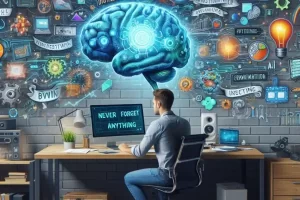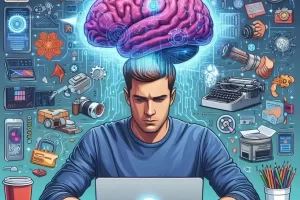Building a second brain used to be a manual, time-consuming process. But in 2025, thanks to major leaps in artificial intelligence, it’s easier, smarter, and more accessible than ever before. Whether you’re a student, entrepreneur, writer, or lifelong learner, AI tools can help you capture, organize, and retrieve knowledge with minimal effort.
In this article, we’ll break down the best AI tools to build a second digital brain that actually works — so you can stop forgetting important information and start maximizing your mental clarity and productivity.
What Makes a Great AI Tool for Your Second Brain?
Before we dive into the list, let’s clarify what qualities to look for in an AI-powered tool:
- Ease of integration with other apps
- Natural language processing to retrieve info conversationally
- Smart tagging, summarizing, and organizing
- Automation capabilities
- Cross-device syncing and backups
These features ensure your second brain works with you, not against you.
Now let’s explore the top tools by category.
🧠 ChatGPT (by OpenAI)
Best for: Conversations, summarizing content, finding patterns, generating ideas
ChatGPT is the brain inside your second brain. It helps you:
- Summarize large notes into digestible insights
- Retrieve stored content using natural language
- Connect unrelated ideas
- Write journal entries, reviews, and plans
- Generate tags and structure your data
Use Cases:
“Summarize this 10-page meeting transcript.”
“What were the main takeaways from my last 5 book notes?”
“Turn these bullet points into a full blog post draft.”
Bonus: With ChatGPT’s custom GPTs and memory features, you can create a personalized assistant trained on your note-taking style and structure.
📒 Notion AI
Best for: All-in-one organization, notes, content creation
Notion was already one of the most powerful second-brain tools — but with Notion AI, it now offers:
- Contextual note summaries
- AI writing suggestions
- Auto task generation from content
- Translation and formatting
Notion AI lives within your notes, making your database smarter without disrupting your workflow.
Key Features:
- Ask questions like “What’s the key takeaway from this page?”
- Auto-fill missing content in a project plan
- Write better project descriptions using AI prompts
📚 Readwise + Reader
Best for: Capturing highlights from books, articles, and podcasts
Readwise is the memory layer of your second brain. Its AI-powered system:
- Imports highlights from Kindle, Pocket, Twitter, and more
- Auto-syncs with Notion or Obsidian
- Suggests smart review cycles (Spaced Repetition)
- Summarizes saved content with AI
- Connects quotes and notes by theme
Reader by Readwise is also a powerful tool on its own for reading articles and saving highlights with instant summaries.
🔗 Obsidian + AI Plugins
Best for: Personal knowledge graph, backlinking, and deep idea linking
Obsidian is a markdown-based note-taking app known for:
- Local file storage
- Zettelkasten method support
- Bi-directional linking
With AI plugins, you can now:
- Summarize notes
- Suggest links between concepts
- Auto-categorize entries
- Answer questions based on your entire vault
Bonus: You can embed ChatGPT responses inside Obsidian notes using plugins.
🗂️ Mem.ai
Best for: Fully AI-native second brain experience
Mem is built entirely around AI. It offers:
- Auto-tagging and auto-linking
- Smart search with natural language
- Context-aware reminders
- Daily digests and note resurfacing
Think of it as your assistant that remembers everything — with zero manual organization required.
🔄 Reflect
Best for: Journaling, self-reflection, personal growth
Reflect is a beautifully designed app that integrates with AI to:
- Turn journaling into a deeper habit
- Suggest insights from your past entries
- Help generate new thoughts or ideas
- Link concepts in your thinking over time
If your second brain includes a personal development component, Reflect is ideal.
🧩 Tana
Best for: Visual thinkers and daily knowledge flows
Tana is a node-based AI note app that offers:
- Dynamic tagging
- Real-time AI summaries
- Connections across daily and long-term notes
Its AI assistant surfaces connections and categories that you may not have noticed, helping your second brain evolve organically.
🛠️ Zapier or Make.com
Best for: Automating the backend of your second brain
These platforms don’t organize your thoughts — but they make sure your tools talk to each other.
Examples:
- Save every starred email to Notion
- Sync new Kindle highlights with Obsidian
- Trigger a ChatGPT prompt when a new task is created
Automation ensures you’re not wasting time on routine actions.
📱 Otter.ai
Best for: Voice note transcription and meeting capture
If you use audio for note-taking or attend lots of meetings, Otter:
- Transcribes audio in real-time
- Creates summaries of calls and recordings
- Can send notes to other apps like Notion
Pair it with ChatGPT for even more value:
“Summarize this voice note and suggest 3 takeaways.”
✍️ Evernote (with AI integration)
Best for: Legacy note-takers upgrading to AI
Evernote has recently integrated AI to assist with:
- Note formatting
- Search suggestions
- Summarization
It’s still a viable second brain tool, especially for users already committed to the ecosystem.
How to Choose the Right Tools for You
You don’t need all 10 tools. A great second brain is focused, not bloated. Here’s a basic combo for most users:
Role | Tool
Structure & Notes | Notion or Obsidian
AI Assistant | ChatGPT
Content Capture | Readwise + Reader
Automation | Zapier or Make.com
Reflection | Reflect or Otter.ai
Ask yourself:
Do I need deep organization (Notion) or speed (Mem)?
Do I prefer voice input (Otter) or text (Obsidian)?
Will I actively review my notes, or want AI to prompt me?
Match the tool to your working style.
Final Thoughts: Build Smart, Not Complicated
AI has revolutionized how we think, remember, and learn. With the right tools, your second brain becomes more than just a filing cabinet — it becomes a thinking partner.
Start with two or three tools from this list, get familiar, and build slowly. The key is consistency and integration, not perfection.
By combining smart systems with AI, you’ll unlock a level of productivity and mental clarity that truly feels like you’re running with a second brain.




